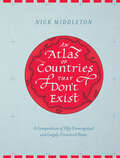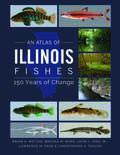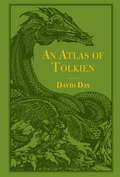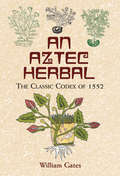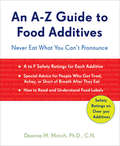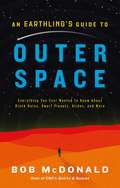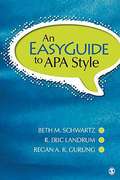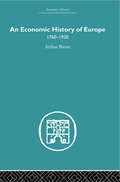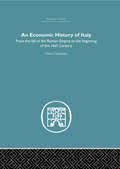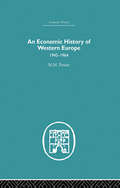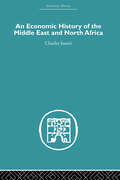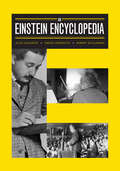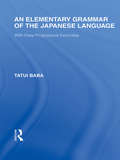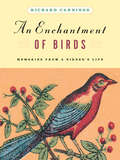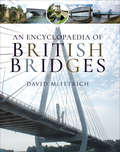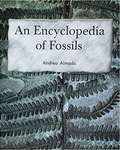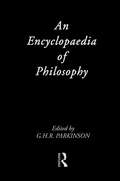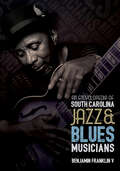- Table View
- List View
An Assessment of the National Institute of Standards and Technology Center for Neutron Research
by National Research Council Panel on Neutron ResearchThe National Institute of Standards and Technology [NIST] Center for Neutron Research (NCNR) is a national user facility whose mission is to ensure the availability of neutron measurement capabilities in order to meet the needs of U.S. researchers from industry, academia, and government agencies.<P><P> This mission is aligned with the mission of NIST, which is to promote U.S. innovation and industrial competitiveness by advancing measurement science, standards, and technology in ways that enhance economic security and improve the quality of life.
An Atlas of Countries That Don't Exist: A Compendium of Fifty Unrecognized and Largely Unnoticed States
by Nick MiddletonA “fascinating” journey to little-known and contested lands around the globe, from Tibet to the Isle of Man to Elgaland-Vargaland (Geographical Magazine).What is a country? Acclaimed travel writer and Oxford geography don Nick Middleton brings to life the origins and histories of fifty states that, lacking international recognition and United Nations membership, exist on the margins of legitimacy in the global order. From long-contested lands like Crimea and Tibet to lesser-known territories such as Africa’s last colony and a European republic that enjoyed independence for a single day, Middleton presents fascinating stories of shifting borders, visionary leaders, and “forgotten” peoples. “Engrossing . . . You’ll not find Middle-earth, Atlantis or Lilliput inside, but you will find something just as intriguing . . . sure to prompt discussions about what makes a country a ‘real country.’” —Seattle Times
An Atlas of Endangered Alphabets: Writing Systems on the Verge of Vanishing
by Tim BrookesA global exploration of the many writing systems that are on the verge of vanishing, and the stories and cultures they carry with them.If something is important, we write it down. Yet 85% of the world's writing systems are on the verge of vanishing - not granted official status, not taught in schools, discouraged and dismissed.When a culture is forced to abandon its traditional script, everything it has written for hundreds of years - sacred texts, poems, personal correspondence, legal documents, the collective experience, wisdom and identity of a people - is lost.This Atlas is about those writing systems, and the people who are trying to save them. From the ancient holy alphabets of the Middle East, now used only by tiny sects, to newly created African alphabets designed to keep cultural traditions alive in the twenty-first century: from a Sudanese script based on the ownership marks traditionally branded into camels, to a secret system used in one corner of China exclusively by women to record the songs and stories of their inner selves: this unique book profiles dozens of scripts and the cultures they encapsulate, offering glimpses of worlds unknown to us - and ways of saving them from vanishing entirely.
An Atlas of Endangered Alphabets: Writing Systems on the Verge of Vanishing
by Tim BrookesA global exploration of the many writing systems that are on the verge of vanishing, and the stories and cultures they carry with them.If something is important, we write it down. Yet 85% of the world's writing systems are on the verge of vanishing - not granted official status, not taught in schools, discouraged and dismissed.When a culture is forced to abandon its traditional script, everything it has written for hundreds of years - sacred texts, poems, personal correspondence, legal documents, the collective experience, wisdom and identity of a people - is lost.This Atlas is about those writing systems, and the people who are trying to save them. From the ancient holy alphabets of the Middle East, now used only by tiny sects, to newly created African alphabets designed to keep cultural traditions alive in the twenty-first century: from a Sudanese script based on the ownership marks traditionally branded into camels, to a secret system used in one corner of China exclusively by women to record the songs and stories of their inner selves: this unique book profiles dozens of scripts and the cultures they encapsulate, offering glimpses of worlds unknown to us - and ways of saving them from vanishing entirely.
An Atlas of Illinois Fishes: 150 Years of Change
by Brooks M. Burr Brian A. Metzke Leon C. Hinz Jr. Lawrence M. Page Christopher A. TaylorLake Michigan, winding creeks, sprawling swamps, and one of the world’s great rivers--Illinois’s variety of aquatic habitats makes the Prairie State home to a diverse array of fishes. The first book of its kind in over forty years, An Atlas of Illinois Fishes is a combination of nature guide and natural history. It provides readers with an authoritative resource based on the extensive biological data collected by scientists since the mid-1850s. Each of the entries on Illinois’s 217 current and extirpated fish species offers one or more color photographs; maps depicting distributions at three time periods; descriptions of identifying features; notes on habitat preference; and comments on distribution. In addition, the authors provide a pictorial key for identifying Illinois fishes. Scientifically up-to-date and illustrated with over 240 color photos, An Atlas of Illinois Fishes is a benchmark in the study of Illinois’s ever-changing fish communities and the habitats that support them.
An Atlas of Poverty in America: One Nation, Pulling Apart 1960–2003
by Amy GlasmeierPersistant poverty has long been one of America's most pressing and intractable problems. According to some estimates, by 2003, almost twenty-five percent of the America's countries had per-capita incomes below one half the national average, high unemployment, low labour force participation rates, and a high dependency on government transfer payments - all measures of economic distress. An Atlas of Poverty in America shows how and where America's regional development patterns have become more uneven, and graphically illustrates the increasing number of communities falling behind the national economic average. Readers will be able to use this Atlas to see how major events and trends have impacted the scope and extent of American poverty in the past half-century:economic globalization, the rise of the sunbelt, decline of the welfare state, and the civil rights movement. Also includes 195 colour maps.
An Atlas of Tolkien: An Illustrated Exploration of Tolkien's World (Tolkien)
by David DayThis lavish, colour atlas is a complete guide to the weird and wonderful geography of Tolkien's world. Packed with full page maps and illustrations of events in the annals of Middle-earth, it is the perfect companion to the bestselling A Dictionary of Tolkien. This book is unofficial and is not authorised by the Tolkien Estate or HarperCollins Publishers.
An Aztec Herbal: The Classic Codex of 1552 (Native American)
by William GatesOriginally written in the Aztec language, this 16th-century codex was the first herbal and medical text compiled in the New World. It contains ancient remedies for myriad ailments -- boils, hair loss, cataracts, insomnia hiccoughs, and gout, to name a few. Analytical Index to Plants. New Introduction. Over 180 black-and-white and 38 color illustrations.
An A–Z Guide to Food Additives: Never Eat What You Can't Pronounce
by Deanna M. MinichA reference for decoding what those mysterious ingredients are—and how they may affect you: “The definitive guide for the health-conscious shopper.” —Robert H. Lerman, MD, PhDHere’s a tongue twister: Say cochineal extract, diacetyl, tertiary butylhydroquinone, BHA, HFCS, and MSG. It's not just knowing how to pronounce what’s in your food that’s important, it's knowing what it does and how it can affect you. The average American consumes about 150 pounds of food additives per year. With so many processed foods on the supermarket shelves, it can be hard to navigate the waters to an additive-free diet.A-Z Guide to Food Additives helps you change the way you eat and shop—providing heart-healthy tips while helping you avoid undesirable food additives. Also, you’ll get the rundown on which additives do no harm and may even be nutritious. This “additive translator” lets you head down to your grocery store with a grocery list in one hand and your newfound knowledge in the other.A-Z Guide to Food Additives delivers:Essential nutrition adviceHints on what to look for when reading those unreadable ingredient labelsTips on buying fresh produce in order to avoid pesticidesInformation on ingredients that can contribute to headaches, bloating, breathing difficulties, and other problemsSafety ratings for 300 ingredientsReference charts for additives that may cause cancer or allergic reactions, or should be limited for sodium-sensitive people
An A–Z Guide to Healing Foods: A Shopper's Reference (Conari Wellness)
by Elise Marie CollinsFind foods that fill you with a sense of well-being—and benefit your body—with this alphabetical, cross-referenced guide: “Fantastic.” —Christiane Northrup, MD, #1 New York Times-bestselling author of Women’s Bodies, Women’s WisdomFilled with scientific information, natural remedies, and modern wisdom, this concise reference is for anyone confused by all the nutritional claims out there. How do you separate real benefits from marketing hype? What is a “superfood” anyway? Alternative health expert Elise Collins has compiled a compact yet comprehensive list of hundreds of healing foods, their vitamin and mineral content, and what they do to promote health, prevent disease, and decrease symptoms of illness.Arranged alphabetically and complete with a cross-reference for what's best to eat for specific ailments, this guidebook is designed to be as convenient as a shopping list. Included are preparation tips and recipes to make this the ultimate tool for joyful eating and radiant health.“Encyclopedic information on the nutritional, medical, and holistic benefits of foods.” —Dana Jacobi, author of 12 Best Foods Cookbook
An Earthling's Guide to Outer Space: Everything You Ever Wanted to Know About Black Holes, Dwarf Planets, Aliens, and More
by Bob McDonaldBeloved science commentator Bob McDonald takes us on a tour of our galaxy, unraveling the mysteries of the universe and helping us navigate our place among the stars.How big is our galaxy? Is there life on those distant planets? Are we really made of star dust? And where do stars even come from? In An Earthling’s Guide to Outer Space, we finally have the answers to all those questions and more. With clarity, wisdom, and a great deal of enthusiasm, McDonald explores the curiosities of the big blue planet we call home as well as our galactic neighbours—from Martian caves to storm clouds on Jupiter to the nebulae at the far end of the universe. So if you’re pondering how to become an astronaut, or what dark matter really is, or how an asteroid wiped out the dinosaurs, look no further. Through a captivating mix of stories, experiments, and illustrations, McDonald walks us through space exploration past and present, and reveals what we can look forward to in the future. An Earthling’s Guide to Outer Space is sure to satisfy science readers of all ages, and to remind us earthbound terrestrials just how special our place in the universe truly is.
An EasyGuide to APA Style
by Regan A. R. Gurung Beth M. Schwartz R. Eric LandrumDemystifying the process of writing in APA style and format, this handy guide presents precise examples (both writing examples and Microsoft Word screenshots) and points out common APA style and formatting mistakes and how to avoid them. Written in a conversational and clear style, this guide will help anyone find their way through the maze of rules in the APA Publication Manual and become proficient in learning the fine points of APA style. Key Features: - Offers guidelines and essential tips based on the sixth edition of the Publication Manual of the American Psychological Association (2009) - Explains the differences between writing in APA style and using APA format - Chapter Two, Your Visual Guide to APA Style, provides a "QuickFinder" for key issues and style points using a Sample Paper - Annotated paper and examples make it easy for readers to understand the nuances of AP?A style - A separate chapter on mistakes to avoid provides a quick and easy guide to common errors that people make when formatting their papers - A companion website with answers to the exercises in the book, additional exercises to further test your understanding of the format and style rules, additional study aids, updated information about APA format, links to other helpful web sites and resources
An Economic History of Europe 1760-1930
by a. BirnieA history of the rise of industrialism in modern Europe, containing a description of the revolutionary changes which transformed industry, commerce and agriculture at the beginning of the last century, with an account of their reactions on the political and economic condition of the chief European nations. The social problems created by this momentous revolution are discussed in detail, and a historical survey is given of the various attempts to correct the evils of industrialism, on the one hand through state intervention by means of poor laws, factory laws, schemes of social insurance, etc., and on the other through voluntary effort as manifested in movements like trade unionism, co-operation, profit sharing and co-partnership. Post-war developments such as the Russian Revolution and international labour legislation are also described in detail and depth. This book was first published in 1930.
An Economic History of Italy: From the Fall of the Empire to the Beginning of the 16th Century
by Gino LuzzattoThis book is the first to provide English readers with a brief and comprehensive survey of economic life in Italy during the period of its greatest splendour: the Middle Ages and Renaissance. The wealth of Renaissance Italy was the product of centuries of growth, and the great Renaissance cities, Venice, Milan and Florence, were first and foremost centres of international trade, which taught the rest of Europe the rudiments of modern business techniques. In a masterly synthesis, based upon a lifetime of study and research, Professor Gino Luzzatto, the greatest of living Italian historians, describes the main changes in Italian economic conditions from the end of the Roman Empire, when Italy ceased to be the centre of a European state, to the end of the Middle Ages when Italy lost the leadership of European trade and banking. The narrative chapters, which deal with barbarian Italy, feudal Italy and Italy in the age of the communes, are followed by a valuable analysis of medieval agriculture, industry, commerce and finance, in her principal Italian states. The range of discussion is wide and offers an excellent introduction to the economic history not only of Italy but of the whole Mediterranean region. This classic text was first published in 1961.
An Economic History of Western Europe 1945-1964 (Economic History Ser.)
by M.M PostanFirst Published in 2005. Routledge is an imprint of Taylor & Francis, an informa company.
An Economic History of the Middle East and North Africa
by Charles IssawiThe economic history of the Middle East and North Africa is quite extraordinary. This is an axiomatic statement, but the very nature of the economic changes that have stemmed directly from the effects of oil resources in these areas has tended to obscure longterm patterns of economic change and the fundamental transformation of Middle Eastern and North African economies and societies over the past two hundred years. In this study Professor Issawi examines and explains the development of these economies since 1800, focusing particularly on the challenge posed by the use and subsequent decline of Western economic and political domination and the Middle Eastern response to it. The book beg ins with an analysis of the effects of foreign intervention in the area: the expansion of trade, the development of transport networks, the influx of foreign capital and resulting integration into international commercial and financial networks. It goes on to examine the local response to these external forces: migration within, to and from the region, population growth, urbanization and changes in living standards, shifts in agricultural production and land tenure and the development of an industrial sector. Professor Issawi discusses the crucial effects of the growth of oil and oil-related industries in a separate chapter, and finally assesses the likely gains and losses in this long period for both the countries in the area and the Western powers. He has drawn on long experience and an immense amount of material in surveying the period, and provides a clear and penetrating survey of an extraordinarily complex area.
An Einstein Encyclopedia
by Alice Calaprice Robert Schulmann Daniel KennefickThis is the single most complete guide to Albert Einstein's life and work for students, researchers, and browsers alike. Written by three leading Einstein scholars who draw on their combined wealth of expertise gained during their work on the Collected Papers of Albert Einstein, this authoritative and accessible reference features more than one hundred entries and is divided into three parts covering the personal, scientific, and public spheres of Einstein's life.An Einstein Encyclopedia contains entries on Einstein's birth and death, family and romantic relationships, honors and awards, educational institutions where he studied and worked, citizenships and immigration to America, hobbies and travels, plus the people he befriended and the history of his archives and the Einstein Papers Project. Entries on Einstein's scientific theories provide useful background and context, along with details about his assistants, collaborators, and rivals, as well as physics concepts related to his work. Coverage of Einstein's role in public life includes entries on his Jewish identity, humanitarian and civil rights involvements, political and educational philosophies, religion, and more.Commemorating the hundredth anniversary of the theory of general relativity, An Einstein Encyclopedia also includes a chronology of Einstein's life and appendixes that provide information for further reading and research, including an annotated list of a selection of Einstein's publications and a review of selected books about Einstein.More than 100 entries cover the rich details of Einstein's personal, professional, and public lifeAuthoritative entries explain Einstein's family relationships, scientific achievements, political activities, religious views, and moreMore than 40 illustrations include photos of Einstein and his circle plus archival materialsA chronology of Einstein's life, appendixes, and suggestions for further reading provide essential details for further research
An Elementary Grammar of the Japanese Language: With Easy Progressive Exercises (Routledge Library Editions: Japan)
by Tatui BabaWhen originally published in 1873 one of the aims was to protest against an idea that the Japanese language was very imperfect, and therefore it should be exterminated! The second was to give a general idea of the Japanese language as it is spoken.
An Enchantment of Birds
by Richard CanningsIn these delightful meditations, biologist and bird lover Richard Cannings weaves stories of his personal encounters with birds into fascinating descriptions of their behavior, anatomy, and evolution. He muses over the meadowlarks' ability to hide their nests so completely that he has seen only two in a lifetime spent searching for them; the trumpeter swan, as picky as a two-year old, devouring potatoes and carrots but turning up its beak at Brussels sprouts; the northern gannet, with its snowy plumage, black wingtips, and startling blue eyes; the little saw-whet owl, which dabbles in bigamy and even trigamy; and more than two dozen other birds. Covering the entire continent, from the cacophony of a seabird colony on the shores of the Atlantic to a symphony of snow geese on the autumn plains to songbird courtship in the alpine tundra of the Rockies, An Enchantment of Birds informs and entertains, in one fell swoop.
An Encyclopaedia of British Bridges
by David McFetrich&“An already impressive reference work has been made significantly more valuable . . . a well-illustrated alphabetized compendium of notable bridges.&” —The Happy Pontist Bridges have a universal appeal as examples of man&’s mastery of nature, from picturesque packhorse bridges to great spans stretching across broad estuaries, and the development of the technology that allows ever more audacious constructions is never-ending. Of the million or more bridges throughout Great Britain, David McFetrich has selected those that are significant in terms of their design, construction or location, or of their connections with people or events of history. His definitive book contains 1,600 separate entries for individual bridge sites or related groups of bridges covering more than 2,000 different structures, 165 general entries about different types of bridge and such topics as collapses and failures, and a summary of about 200 record-holding bridges in 50 different categories. The concise text is supported by more than 900 illustrations and diagrams. The result is a fascinating and readily accessible compendium. The Institute of Civil Engineers (ICA) is also on board. &“A valuable resource to use . . . if you plan to visit some of these structures while on holiday or are merely planning a day out.&” —East Yorkshire Family History Society &“Well-written and researched and eminently readable . . . Because of the ubiquity of bridges throughout Great Britain, this volume should have wide appeal.&” —NZ Crown Mines &“Full of details covering the many bridges around the UK . . . I found it fascinating to see the variety of bridges around Britain, even the ones not railway related.&” —Rail Advent
An Encyclopedia of Animals (On Our Way to English #Level M)
by Elizabeth MassieWith so many animals in the world, how can we tell the difference between them? One way is to group together animals that have things in common. You will notice that all of the animals in this book have a backbone. You have a backbone, too. It is the bone that runs down your back.
An Encyclopedia of Fossils (Rigby Leveled Library, Level M #71)
by Andrea AlmadaNIMAC-sourced textbook
An Encyclopedia of Philosophy (Routledge Companion Encyclopedias)
by G.H.R. Parkinson* Presents a broad survey of philosophical thought* Each chapter explores, and places in context, a major area of philosophical enquiry - including the theory of meaning and of truth, the theory of knowledge, the philosophies of mathematics, science and metaphysics, the philosophy of mind, moral and political philosophy, aesthetics, and religion* Annotated bibliographies for each chapter and indexes of names and subjects * Glossary of commonly-used philosophical terms* Chronological table of the history of philosophy from 1600`It is a fine achievement and deserves the warmest praise ... Anyone interested in learning what contemporary philosophical debate is about will find this book invaluable ... for a book of this size and quality of content the cover price is modest. Every public library as well as every university, college and school library should have a copy on its shelves.' - Times Higher Education Supplement`A stimulating collection.' - Reference Reviews
An Encyclopedia of South Carolina Jazz & Blues Musicians
by Benjamin Franklin VThis comprehensive A-to-Z reference is “an impressive contribution to jazz history and surprisingly good reading” (Michael Ullman, author of Jazz Lives).This informative bookdocuments the careers of South Carolina jazz and blues musicians from the nineteenth century to the present. The musicians range from the renowned (James Brown, Dizzy Gillespie), to the notable (Freddie Green, Josh White), the largely forgotten (Fud Livingston, Josie Miles), the obscure (Lottie Frost Hightower, Horace “Spoons” Williams), and the unknown (Vince Arnold, Johnny Wilson).Though the term “jazz” is commonly understood, if difficult to define, “blues” has evolved over time to include R&B, doo-wop, and soul. Performers in these genres are also represented, as are members of the Jenkins Orphanage bands of Charleston. Also covered are nineteenth-century musicians who performed what might be called proto-jazz or proto-blues in string bands, medicine shows, vaudeville, and the like.Organized alphabetically, from Johnny Acey to Webster Young, the entries include basic biographical information, South Carolina residences, career details, compositions, recordings as leaders and as band members, films, awards, websites, and lists of resources for additional reading. Former host of Jazz in Retrospect on NPR Benjamin Franklin V has ensured biographical accuracy to the greatest degree possible by consulting numerous public documents, and information in these records permitted him to dispel myths and correct misinformation that have surrounded South Carolina’s musical history for generations.“Elucidates South Carolina as a profoundly crucial puzzle piece alongside New Orleans, Chicago, Kansas City and New York.” —Harry Skoler, professor, Berklee College of MusicIncludes photos

